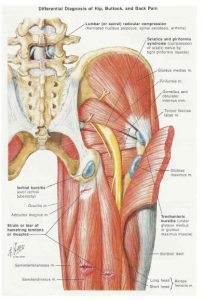Piriformis Syndrome is a common type of running injury. This video and article will help you identify piriformis pain symptoms as well as distinguish between Piriformis Pain and Sciatica.
The Piriformis Muscle
 The Piriformis Muscle belongs with the gluteal group. The piriformis muscle laterally rotates the hip joint. Lateral rotation of the hip points the knee away from the midline of the body, or points the toes away from the midline of the body (duck feet). This action is important because it supports the hip joint, along with other muscles of the gluteal region. Lateral rotation of the hip is kept in check by the glute medius and glute minimus which are responsible for medial rotation (towards the midline of the body). This is an important differentiation when it comes to appropriate diagnosis of the “pain in my butt” syndrome.
The Piriformis Muscle belongs with the gluteal group. The piriformis muscle laterally rotates the hip joint. Lateral rotation of the hip points the knee away from the midline of the body, or points the toes away from the midline of the body (duck feet). This action is important because it supports the hip joint, along with other muscles of the gluteal region. Lateral rotation of the hip is kept in check by the glute medius and glute minimus which are responsible for medial rotation (towards the midline of the body). This is an important differentiation when it comes to appropriate diagnosis of the “pain in my butt” syndrome.
What Is Piriformis Syndrome?
Piriformis Syndrome is a condition where the piriformis muscle irritates the sciatic nerve. This can result in pain in the glute area, as well as possible pain down the back of the leg, which is similar to pain resulting from sciatica. Piriformis Syndrome is most common in active people (runners, walkers, cyclists) because of the repetitive lateral rotation of the hip and extension of the femur to achieve a gait cycle or pedal stroke.
Symptoms of Piriformis Syndrome
Not a day goes by that a runner at the San Diego Running Institute does not complain of gluteal pain before, during or after their run. “Butt” pain can be Piriformis Syndrome, Gluteus medius tendonitis or strain, hip bursitis or Sciatica. The runner will usually explain that they have a deep, aching pain “in their butt” that can get worse as they run longer, faster or on hills. Sciatica is a completely different condition and Piriformis Syndrome is not the cause of sciatica. Typical symptoms of piriformis syndrome may include: a dull ache in mid-glute region, pain in the back of the leg, pain walking up stairs or steep inclines, and excessive pain after sitting for long periods.
Testing For Piriformis Syndrome
Dr. Allen D.C. routinely treats patients that complain of this “pain in the butt” problem and has specific tests that he does to differentiate between sciatica and true piriformis syndrome. Dr. Allen D.C. performs what is called the Slumps Test to diagnose for sciatica. In this test, the patient is seated and extends their knee while bringing their chin towards their chest. A positive test results in pain shooting down their affected leg and sometimes into the foot. When testing for Piriformis Syndrome, Dr. Allen D.C. has the patient cross their leg so they are sitting in a “Tailors” position. They then arch their lumbar spine. A positive test is indicated by pain felt in the Gluteal region and an inability of their leg to sit at 80-90 degrees. Obtaining the appropriate diagnosis will result in the right type of treatment path for you and will reduce time spent dealing with the condition.
Piriformis Pain Treatment – Quick Fixes
San Diego Running Institute have some “quick-fixes” for gluteal pain. First the foam roller can be used to effectively massage the gluteal muscles. Compression shorts can be worn that provide support to the gluteus medius and reduce strain. The Stick can also be used for effective self massage to the glutes and piriformis muscles. All of these products that are effective in the treatment for gluteal pain or Piriformis Syndrome can be purchased at the San Diego Running Institute for under $40. The products combined with rest, stretching and other good habits will hopefully help the runner ease their “butt” pain.
Piriformis Pain Treatment – Dr. Allen’s Recommendations
If these simple, quick fixes for piriformis syndrome fail the San Diego Running Institute can refer you to Dr. Allen D.C. If you have “butt” pain, hip pain or lower back pain or have already been diagnosed with piriformis syndrome and you would like to make an appointment directly with Dr. Allen D.C. you can call (858) 268-8525.
